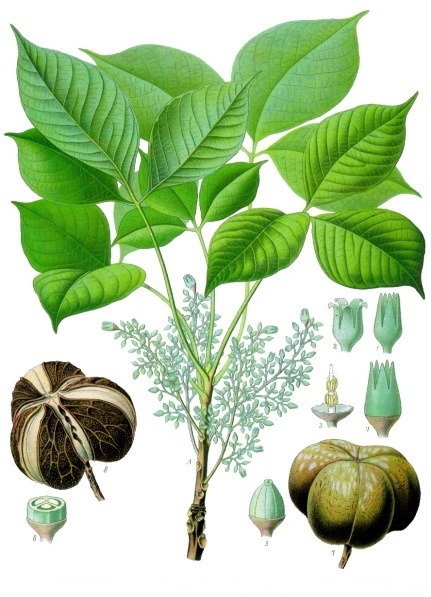- Para rubber tree
Taxobox
name = Rubber Tree

image_width = 200px
image_caption = "Hevea brasiliensis"
regnum =Plantae
divisio = Magnoliophyta
classis =Magnoliopsida
ordo =Malpighiales
familia =Euphorbiaceae
subfamilia =Crotonoideae
tribus =Micrandreae
subtribus =Heveinae
genus = "Hevea "
species = "H. brasiliensis"
binomial = "Hevea brasiliensis"
binomial_authority = Müll.Arg.The Pará rubber tree ("Hevea brasiliensis"), often simply called rubber tree, is a
tree belonging to the familyEuphorbiaceae and the most economically important member of the genus "Hevea". It is of major economic importance because its sap-like extract (known aslatex ) can be collected and is the primary source of naturalrubber .Description
The tree can reach a height of over 30m (98.4 feet). The white or yellow latex occurs in latex vessels in the
bark , mostly outside thephloem . These vessels spiral up the tree in a right-handedspiral which forms anangle of about 30 degrees with the horizontal.Harvest
Once the trees are 5-6 years old, the harvest can begin: incisions are made orthogonal to the latex vessels, just deep enough to tap the vessels without harming the tree's growth, and the sap is collected in small buckets. This process is known as
rubber tapping . Older trees yield more latex, but they stop producing after 26-30 years.History
The Pará rubber tree initially grew only in the
Amazon Rainforest . Increasing demand and the discovery of thevulcanization procedure in 1839 led to a boom in that region, enriching the cities ofBelém andManaus . The name of the tree derives fromPará , the second largest Brazilian state, that contains Belém as capital, mainly city and tech-financial centre.There had been an attempt made, in 1873, to grow rubber outside
Brazil . After some effort, twelve seedlings were germinated at theRoyal Botanic Gardens, Kew . These were sent toIndia for cultivation, but died. A second attempt was then made, some 70,000 seeds being sent to Kew in 1875. About 4% of these germinated, and in 1876 about 2000 seedlings were sent, inWardian case s, toCeylon , and 22 sent to the Botanic Gardens inSingapore . Once established outside its native country, rubber was extensively propagated in the British colonies. Rubber trees were brought to the botanical gardens at Buitenzorg, Java in 1883.cite book | last = Winchester | first = Simon | title = Krakatoa: The Day the World Exploded, August 27, 1883 |pages=223-224 | publisher = HarperCollins | year = 2003 | id = ISBN 0-06-621285-5 ] By 1898, a rubber plantation had been established in Malaya, and today most rubber tree plantations are inSoutheast Asia and some also in tropicalAfrica . Efforts to cultivate the tree in its native South America were unsatisfactory.Fact|date=September 2008Uses
The wood from this tree, referred to as parawood or rubberwood, is used in the manufacture of high-end furniture. It is valued for its dense grain, minimal shrinkage, attractive colour and acceptance of different finishes. It is also prized as an "environmentally friendly" wood, as it makes use of trees that have been cut down at the end of their latex-producing cycle.
ynonyms
The genus "Hevea" is also known as:
*"Caoutchoua"J.F.Gmel.
*"Micrandra"Benn. & R.Br.
*"Siphonanthus"Schreb. ex Baill.
*"Siphonia"D.Richard exSchreb. ee also
* "
Castilla elastica " - the principal source of latex rubber among the pre-Columbian MesoAmerican peoples
*List of plants of Amazon Rainforest vegetation of Brazil Gallery
References
* [http://www.greenlivingtips.com/articles/142/1/Sustainable-Rubberwood.html Sustainable Rubberwood]
Further references
Zhang, J., Huss, V.A.R., Sun, X., Chang, K. and Pan, D. 2008. Morphology and phylogenetic position of a trebouxiophycean green algae (Chlorophyta) growing on th rubber tree, "Hevea brasiliensis", with the description of a new genus and species. "Eur. J. Phycol." 43(2): 185 - 193.
Wikimedia Foundation. 2010.
